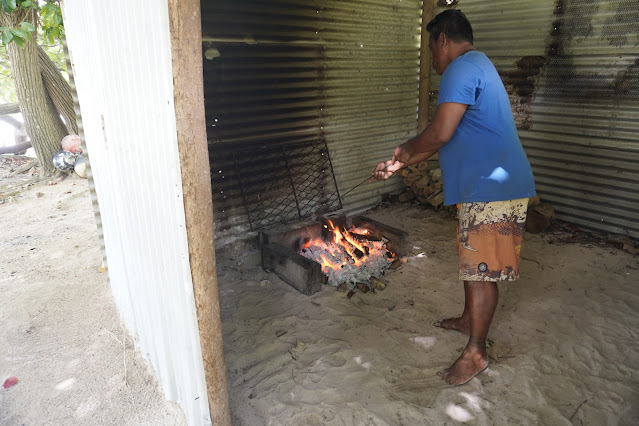- Get link
- X
- Other Apps
Whoever comes to French Polynesia for the first time, is very taken by the friendliness of the people. No matter where you come or where you go, you are greeted with "bonjour ca va". Also, one always has a smile left for us. We immediately feel very comfortable and are charmed by the cleanliness of the gardens, the beaches and in general the entire island of Mangareva. Lock the dinghy, or barricade the ship, where are you thinking? Are you trying to insult me? Here on the Gambiers nothing gets away. Rikitea is the only major settlement on the Gambiers. Chickens run across the road, and except for a couple of grocery stores and two restaurants, there is nothing here. The restaurants close at 2 o'clock in the afternoon and everything is closed on holidays. Diesel is ordered in 200l barrels from Tahiti, spare parts for the boat as well. It is a quiet place. The largest building in Rikitea is the church, which is comparable in size to a church in a small European town. Somehow it doesn't really fit into the landscape for me, but maybe I'll get used to it. Likewise, there are conifers on the island, or the Canary Island pine, with its long needles. In the otherwise tropical vegetation also an exotic. During a hike to Mount Duff, we see that this forest was reforested, because the trees, stand accurately in a row. The water is turquoise to dark blue depending on how deep it is and the coral sticks partly come up to the surface. There is no loud music here, and although there are a lot of cars for the small island, the traffic noise is extremely low and comes to a complete standstill at night. We enjoy this unique silence. People are very considerate of each other here. By the way, there is no gas station on the island. So everybody has his own methods to refuel a car. All in all, there is still a lot for us to discover and we are at the beginning of our stay on the Gambiers.
 |
| When guests come the barbecue is fired up |
On Sunday after our arrival, the wind starts to shift. First to northeast and then to northwest. We are in the shade of Mangareva and as the wind dies down, the bay becomes calmer as well. The weather starts to get better and the sun comes out. We set off to explore the island. We walk along the road over a saddle to the northwestern side of the island. Past papayas, coffee, chili and grapefruits. In the first bend after the saddle, the trail to the two mountains Mont Mokoto and Mont Auorotini, also called Mont Duff, begins. At a crossroads we have to decide if we want to go to the highest or second highest mountain. We decide for the Mont Duff, which with 440 meters height, is 20 meters higher than the Mont Mokoto. The path becomes steeper and steeper and to get to the top you have to climb a little bit. In return, one enjoys a tremendous panoramic view. The whole archipelago is at your feet. You can see the islands Taravai, Akamaru and Temoe. Also the outer reef with its motus. Over a rope it goes again steeply, along the ridge, downhill. But you shouldn't rely too much on the rope, because it looks quite worn in some places. Once you have overcome the steepest passages, you dive back into the pine forest and get over the ridge to the other side to the ascent of Mont Mokoto. At another fork in the road, we turn off towards Rikitea and, crossing the southern side of the island, we return to the village with the Saint Michel Cathedral. I notice that my condition has decreased considerably. Have I in the past about one to two thousand meters of altitude only little broken my head, I notice now already, the almost 500 meters of altitude on this day considerably. My thighs burn and I am glad that we have reached Rikitea again. A scent of lime is in the air and we pass numerous gardens. A pig is tied to a rope and starts to grunt when it sees us. A horse stands in half-high grass and the farm dogs bark when we pass. It is a village idyll and there is hardly anyone on the streets at this time of day. Tired, we slog along the road and finally reach the dinghy dock. With some effort, we free our feet from the unfamiliar footwear. Since Colombia I had no more hiking shoes on and in Panama at most times a pair of sneakers. Otherwise we walk around barefoot or with flip flops. Hiking shoes take a lot of getting used to. Back on the Katinka, first of all the liquid balance is brought in order again. As always, we have drunk far too little on this day. Afterwards we treat ourselves to a shower, after I have filled the tanks again with our water maker. You wouldn't think what a difference such a thing makes. Satisfied we sit in the cockpit and let the evening come. How we are doing in the Gambiers you can read again next week. Until then, always fair winds and keep a stiff upper lip.
- Get link
- X
- Other Apps
Comments
Post a Comment